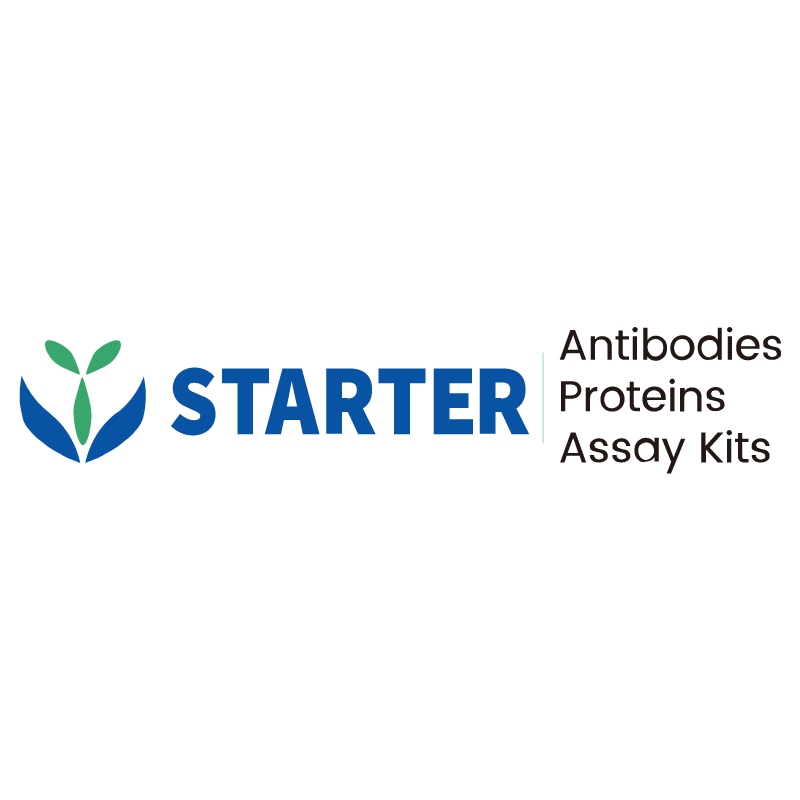WB result of KL Recombinant Rabbit mAb
Primary antibody: KL Recombinant Rabbit mAb at 1/1000 dilution
Lane 1: Jurkat whole cell lysate 20 µg
Lane 2: K562 whole cell lysate 20 µg
Secondary antibody: Goat Anti-rabbit IgG, (H+L), HRP conjugated at 1/10000 dilution
Predicted MW: 116 kDa
Observed MW: 58 kDa
Product Details
Product Details
Product Specification
| Host | Rabbit |
| Antigen | KL |
| Synonyms | Klotho |
| Immunogen | Synthetic Peptide |
| Location | Secreted, Cell membrane |
| Accession | Q9UEF7 |
| Clone Number | S-2245-169 |
| Antibody Type | Recombinant mAb |
| Isotype | IgG |
| Application | WB, IHC-P |
| Reactivity | Hu, Ms, Rt |
| Positive Sample | Jurkat, K562, mouse kidney, mouse testis, rat kidney, rat testis |
| Purification | Protein A |
| Concentration | 0.5 mg/ml |
| Conjugation | Unconjugated |
| Physical Appearance | Liquid |
| Storage Buffer | PBS, 40% Glycerol, 0.05% BSA, 0.03% Proclin 300 |
| Stability & Storage | 12 months from date of receipt / reconstitution, -20 °C as supplied |
Dilution
| application | dilution | species |
| WB | 1:1000 | Hu, Ms, Rt |
| IHC-P | 1:1000 | Hu, Ms, Rt |
Background
KL protein, also known as α-Klotho, is a type-I single-pass transmembrane protein encoded by the KL gene on chromosome 13, featuring a short intracellular tail and a large extracellular region composed of tandem KL1 and KL2 glycosidase-like domains that can be proteolytically cleaved by ADAM10 and other proteases to release a soluble, circulating hormone-like form. Initially discovered as an aging-suppressor, KL functions as a coreceptor for FGF23 to regulate phosphate, calcium, and vitamin D metabolism, while its soluble form modulates insulin/IGF-1 and Wnt signaling, suppresses oxidative stress and inflammation, and enhances synaptic plasticity and cognition; consequently, KL overexpression extends lifespan and improves healthspan in mice, whereas its deficiency accelerates aging phenotypes such as arteriosclerosis, osteoporosis, sarcopenia, and cognitive decline, and human KL variants are associated with hypertension, chronic kidney disease, and age-related disorders .
Picture
Picture
Western Blot
WB result of KL Recombinant Rabbit mAb
Primary antibody: KL Recombinant Rabbit mAb at 1/1000 dilution
Lane 1: mouse kidney lysate 20 µg
Lane 2: mouse testis lysate 20 µg
Secondary antibody: Goat Anti-rabbit IgG, (H+L), HRP conjugated at 1/10000 dilution
Predicted MW: 116 kDa
Observed MW: 55, 130 kDa
WB result of KL Recombinant Rabbit mAb
Primary antibody: KL Recombinant Rabbit mAb at 1/1000 dilution
Lane 1: rat kidney lysate 20 µg
Lane 2: rat testis lysate 20 µg
Secondary antibody: Goat Anti-rabbit IgG, (H+L), HRP conjugated at 1/10000 dilution
Predicted MW: 116 kDa
Observed MW: 55-130 kDa
Immunohistochemistry
IHC shows positive staining in paraffin-embedded human testis. Anti-KL antibody was used at 1/1000 dilution, followed by a HRP Polymer for Mouse & Rabbit IgG (ready to use). Counterstained with hematoxylin. Heat mediated antigen retrieval with Tris/EDTA buffer pH9.0 was performed before commencing with IHC staining protocol.
IHC shows positive staining in paraffin-embedded human kidney. Anti-KL antibody was used at 1/1000 dilution, followed by a HRP Polymer for Mouse & Rabbit IgG (ready to use). Counterstained with hematoxylin. Heat mediated antigen retrieval with Tris/EDTA buffer pH9.0 was performed before commencing with IHC staining protocol.
IHC shows positive staining in paraffin-embedded human breast cancer. Anti-KL antibody was used at 1/1000 dilution, followed by a HRP Polymer for Mouse & Rabbit IgG (ready to use). Counterstained with hematoxylin. Heat mediated antigen retrieval with Tris/EDTA buffer pH9.0 was performed before commencing with IHC staining protocol.
IHC shows positive staining in paraffin-embedded human cervical squamous cell carcinoma. Anti-KL antibody was used at 1/1000 dilution, followed by a HRP Polymer for Mouse & Rabbit IgG (ready to use). Counterstained with hematoxylin. Heat mediated antigen retrieval with Tris/EDTA buffer pH9.0 was performed before commencing with IHC staining protocol.
IHC shows positive staining in paraffin-embedded human lung adenocarcinoma. Anti-KL antibody was used at 1/1000 dilution, followed by a HRP Polymer for Mouse & Rabbit IgG (ready to use). Counterstained with hematoxylin. Heat mediated antigen retrieval with Tris/EDTA buffer pH9.0 was performed before commencing with IHC staining protocol.
IHC shows positive staining in paraffin-embedded human gastric cancer. Anti-KL antibody was used at 1/1000 dilution, followed by a HRP Polymer for Mouse & Rabbit IgG (ready to use). Counterstained with hematoxylin. Heat mediated antigen retrieval with Tris/EDTA buffer pH9.0 was performed before commencing with IHC staining protocol.
IHC shows positive staining in paraffin-embedded mouse testis. Anti-KL antibody was used at 1/1000 dilution, followed by a HRP Polymer for Mouse & Rabbit IgG (ready to use). Counterstained with hematoxylin. Heat mediated antigen retrieval with Tris/EDTA buffer pH9.0 was performed before commencing with IHC staining protocol.
IHC shows positive staining in paraffin-embedded rat colon. Anti-KL antibody was used at 1/1000 dilution, followed by a HRP Polymer for Mouse & Rabbit IgG (ready to use). Counterstained with hematoxylin. Heat mediated antigen retrieval with Tris/EDTA buffer pH9.0 was performed before commencing with IHC staining protocol.


